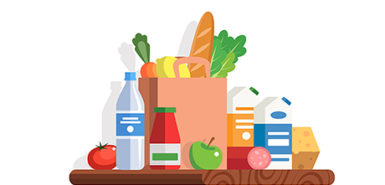
When it comes to healthy eating, we know that fresh is best.
That doesn’t mean all packaged foods are all bad. Savvy shoppers can find healthy options—they just need to know where to look.
That’s where Nutrition Facts labels come in.
When you learn to decode labels, you can better determine which items to buy and which to leave on the shelf, said Kristi Veltkamp, registered dietitian nutritionist at Spectrum Health.
“Cooking fresh is always best,” Veltkamp said. “But if you’re going to use some processed foods, they’re not all bad. That’s where you want to be that food investigator and find the best products.”
The Food and Drug Administration has made that task a bit easier for consumers. Key facts like serving sizes and calories are now in a bolder, larger font.
The FDA also required food companies to list added sugars, knowledge that can help consumers reduce their risk of preventable disease.
“If I had to pick a line that’s most important, that’s probably (it),” Veltkamp said. “Sugar is probably the driver of most diseases—and we get a lot of it.”
Take it from the top
When reading a Nutrition Facts label, look at the serving size first.
“A lot of people skip that part,” Veltkamp said.
Many assume one can of soup equals one serving, for example. Generally, one can equals two to three servings, which means you’re getting two to three times as much sodium, fat or other ingredients.
Food companies tend to list small serving sizes, which can make the other numbers look better. If you’re planning on a larger portion, multiply the amounts of sodium, sugar and calories to get a realistic picture, Veltkamp said.
Get your fats straight
Next up you’ll see total fat, broken down into two categories—saturated and trans fats.
For a helpful mnemonic, remember the “t” in trans fat stands for trouble. Steer clear of it.
“Trans fat is the worst fat you can have, so you want to keep that at zero,” Veltkamp said. “It is a manmade fat that increases the risk of heart disease and high cholesterol. There really is no safe level here.”
Watch for trans fats in salty snacks, baked goods and margarine.
Food companies do not have to report trans fat amounts if the product contains less than half a gram. But it can show up on the ingredients list.
“Any hydrogenated oil is another name for a trans fat,” Veltkamp said.
Saturated fats are typically solid and derived from animal products. Think butter, dairy products and coconut oil.
Veltkamp recommends limiting these to no more than 15 grams per day.
Become a sugar sleuth
Another key category is carbohydrates.
“I don’t look at the total as much as I look at the quality of the carb, which has to do with how much fiber and sugar it has,” Veltkamp said.
For breads and other grain products, she recommends products with 3 grams of fiber for every 15 grams of total carbs.
Always be on the lookout for added sugars.
“You want to differentiate between natural and added sugar,” Veltkamp said. “There’s natural sugar in fruits, yogurt and vegetables. We’re not worried about those. We’re worried about what’s added.”
These added sugars are ubiquitous and addictive—and a major driver of disease.
“It causes inflammation, it can affect joint health, heart health and obviously diabetes,” Veltkamp said. It can also cause tooth decay, liver disease and high cholesterol.
“It’s in everything,” she says. “Condiments, ketchup, barbecue sauce, salad dressing, peanut butter, cereal, yogurt, even crackers and bread.”
The American Heart Association recommends a maximum of 24 grams a day of added sugars for women and 36 grams for men.
Sodium and protein
Food labels also include information about sodium and protein.
Most people should limit sodium to 2,300 milligrams per day. For those with hypertension, heart disease or kidney disease, the amount should be even less.
Protein shakes and protein bars have become increasingly popular. However, most of us only need about 60 grams of protein per day, Veltkamp said. Protein can be found in many foods, including whole grains, vegetables, nuts, beans, meats and dairy.
“Protein shakes aren’t usually necessary unless you are using it as a meal replacement or are an athlete trying to build muscle,” she says.
Detective work
In addition to the information found on the Nutrition Facts label, Veltkamp recommends scanning ingredient lists.
“If it’s got a lot of things that sound like it’s from a chemistry lab, it’s a highly processed food and not the greatest option,” she says.
With a bit of detective work and perhaps a pair of reading glasses, we can find healthy alternatives among the rows of boxes, jars and cans on the grocery store shelves.
“It takes a little longer, and you’ve got to be that food investigator,” Veltkamp said. “There are foods that are healthy. You just have to look for it.”
 /a>
/a>
 /a>
/a>
 /a>
/a>